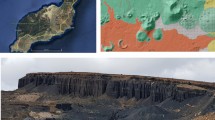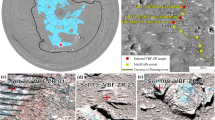Abstract
Space weathering on airless bodies produces metallic iron (Fe0) particles in the rims of mineral grains, which affect visible and near-infrared spectra and complicate the identification of surface materials. The Chang’e-5 mission provides an opportunity to couple information gained from its returned samples with in situ observations and orbital monitoring to gain insight on the details of space weathering on extremely Fe-rich basalts. By putting together all these data, we could extract a soil maturity index (Is/FeO) at the Chang’e-5 landing site of ~66 ± 3.2, indicative of a formation age for the Xu Guangqi crater, whose ejecta dominate the site, of 240–300 Myr ago. In addition, abundant large Fe0 particles were found in the sample, indicating that both the inherited Fe0 particles from late-stage mare basalts and the dense clustering of oversaturated Fe0 in extremely FeO-rich (>17 wt%) basalts contribute to observed Fe0 abundances. We suggest that space weathering of Fe-richer basalt generates Fe0 particles with a larger grain size and faster production rate.
This is a preview of subscription content, access via your institution
Access options
Access Nature and 54 other Nature Portfolio journals
Get Nature+, our best-value online-access subscription
$29.99 / 30 days
cancel any time
Subscribe to this journal
Receive 12 digital issues and online access to articles
$119.00 per year
only $9.92 per issue
Buy this article
- Purchase on Springer Link
- Instant access to full article PDF
Prices may be subject to local taxes which are calculated during checkout





Similar content being viewed by others
Data availability
Large data necessary to generate the results used for this study are available online (https://doi.org/10.6084/m9.figshare.19807858). All original CE-5 data can be found in the Lunar and Planetary Data Release System (http://moon.bao.ac.cn). Source data are provided with this paper.
References
Pieters, C. M. et al. Space weathering on airless bodies: resolving a mystery with lunar samples. Meteorit. Planet. Sci. 35, 1101–1107 (2000).
Pieters, C. M. & Noble, S. K. Space weathering on airless bodies. J. Geophys. Res. Planets 121, 1865–1884 (2016).
McCord, T. B. et al. Moon: near-infrared spectral reflectance, a first good look. J. Geophys. Res. Solid Earth 86, 10883–10892 (1981).
Papike, J., Simon, S. & Laul, J. The lunar regolith: chemistry, mineralogy, and petrology. Rev. Geophys. 20, 761–826 (1982).
Cassidy, W. & Hapke, B. Effects of darkening processes on surfaces of airless bodies. Icarus 25, 371–383 (1975).
Noble, S. K., Pieters, C. M. & Keller, L. P. An experimental approach to understanding the optical effects of space weathering. Icarus 192, 629–642 (2007).
Morris, R. The surface exposure/maturity/of lunar soils—some concepts and Is/FeO compilation. Proc. Lunar Planet. Sci. Conf. 9, 2287–2297 (1978).
Lucey, P. G., Blewett, D. T., Taylor, G. J. & Hawke, B. R. Imaging of lunar surface maturity. J. Geophys. Res. Planets 105, 20377–20386 (2000).
Hapke, B. Bidirectional reflectance spectroscopy: 1. Theory. J. Geophys. Res. Solid Earth 86, 3039–3054 (1981).
Hapke, B. & Sato, H. The porosity of the upper lunar regolith. Icarus 273, 75–83 (2016).
Lue, C. Solar Wind Proton Interactions with Lunar Magnetic Anomalies and Regolith Dissertation, Umeå Univ. (2015).
Gou, S. et al. In situ spectral measurements of space weathering by Chang’e-4 rover. Earth Planet. Sci. Lett. 535, 116117 (2020).
Wang, Z. et al. Submicroscopic metallic iron in lunar soils estimated from the in situ spectra of the Chang’e‐3 mission. Geophys. Res. Lett. 44, 3485–3492 (2017).
Wang, J. et al. Localization of the Chang’e-5 lander using radio-tracking and image-based methods. Remote Sens. 13, 590 (2021).
Li, C. et al. Characteristics of the lunar samples returned by the Chang’e-5 mission. Natl Sci. Rev. 9, nwab188 (2022).
Pieters, C. M. et al. The Moon mineralogy mapper (M³) on Chandrayaan-1. Curr. Sci. 96, 500–505 (2009).
Morris, R. Origins and size distribution of metallic iron particles in the lunar regolith. Proc. Lunar Planet. Sci. Conf. 11, 1697–1712 (1980).
Hapke, B. Space weathering from Mercury to the asteroid belt. J. Geophys. Res. Planets 106, 10039–10073 (2001).
Lucey, P. G. & Riner, M. A. The optical effects of small iron particles that darken but do not redden: evidence of intense space weathering on Mercury. Icarus 212, 451–462 (2011).
Trang, D. & Lucey, P. G. Improved space weathering maps of the lunar surface through radiative transfer modeling of Kaguya multiband imager data. Icarus 321, 307–323 (2019).
Noble, S. K. Turning Rock Into Regolith: The Physical And Optical Consequences of Space Weathering in the Inner Solar System Dissertation, Brown Univ. (2004).
Xu, R. et al. Lunar mineralogical spectrometer on Chang’E-5 mission. Space Sci. Rev. 218, 41 (2022).
Taylor, L. A. et al. Mineralogical and chemical characterization of lunar highland soils: insights into the space weathering of soils on airless bodies. J. Geophys. Res. Planets 115, 2009JE003427 (2010).
Taylor, L. A., Pieters, C. M., Keller, L. P., Morris, R. V. & McKay, D. S. Lunar mare soils: space weathering and the major effects of surface‐correlated nanophase Fe. J. Geophys. Res. Planets 106, 27985–27999 (2001).
Pieters, C. M., Fischer, E. M., Rode, O. & Basu, A. Optical effects of space weathering: the role of the finest fraction. J. Geophys. Res. Planets 98, 20817–20824 (1993).
Pieters, C., Shkuratov, Y., Kaydash, V., Stankevich, D. & Taylor, L. Lunar soil characterization consortium analyses: pyroxene and maturity estimates derived from Clementine image data. Icarus 184, 83–101 (2006).
Xiao, Z., Zeng, Z., Ding, N. & Molaro, J. Mass wasting features on the Moon—how active is the lunar surface? Earth Planet. Sci. Lett. 376, 1–11 (2013).
Schultz, P. & Gault, D. Seismically induced modification of lunar surface features. Proc. Lunar Planet. Sci. Conf. 6, 2845–2862 (1975).
Hou, X. et al. Absolute model ages of three craters in the vicinity of the Chang’e-5 landing site and their geologic implications. Icarus 372, 114730 (2022).
Morris, R. Surface exposure indices of lunar soils—a comparative FMR study. Proc. Lunar Planet. Sci. Conf. 7, 315–335 (1976).
Funkhouser, J. Noble gas analysis of KREEP fragments in lunar soil 12033 and 12070. Earth Planet. Sci. Lett. 12, 263–272 (1971).
Stettler, A., Eberhardt, P., Geiss, J., Grögler, N. & Maurer, P. Ar39–Ar40 ages and Ar37–Ar38 exposure ages of lunar rocks. Proc. Lunar Planet. Sci. Conf. 4, 1865–1888 (1973).
Qian, Y. et al. Copernican-aged (<200 Ma) impact ejecta at the Chang’e‐5 landing site: statistical evidence from crater morphology, morphometry, and degradation models. Geophys. Res. Lett. 48, e2021GL095341 (2021).
Cisowski, C., Dunn, J., Fuller, M., Rose, M. & Wasilewski, P. Impact processes and lunar magnetism. Proc. Lunar Planet. Sci. Conf. 5, 2841–2858 (1974).
El Goresy, A. & Ramdohr, P. Subsolidus reduction of lunar opaque oxides—textures, assemblages, geochemistry, and evidence for a late-stage endogenic gaseous mixture. Proc. Lunar Planet. Sci. Conf. 6, 729–745 (1975).
Rouleau, F. Electromagnetic scattering by compact clusters of spheres. Astron. Astrophys. 310, 686–698 (1996).
Wohlfarth, K. S., Wöhler, C. & Grumpe, A. Space weathering and lunar OH/H2O—insights from ab initio Mie modeling of submicroscopic iron. Astron. J. 158, 80 (2019).
Guo, Z. et al. Nanophase iron particles derived from fayalitic olivine decomposition in Chang’e‐5 lunar soil: implications for thermal effects during impacts. Geophys. Res. Lett. 49, e2021GL097323 (2022).
Gu, L. et al. Space weathering of the Chang’e‐5 lunar sample from a mid‐high latitude region on the Moon. Geophys. Res. Lett. 49, e2022GL097875 (2022).
Xu, J. Y. et al. Characteristics and spectral effects of iron nanoparticles during space weathering of iron-rich olivine. LPI Contrib. 2678, 1889 (2022).
Papike, J., Taylor, L. & Simon, S. Lunar Minerals. In Lunar Sourcebook: A User’s Guide to the Moon (eds Heiken, G. H. et al.) 121–181 (Cambridge Univ. Press, 1991).
Day, J. M. Metal grains in lunar rocks as indicators of igneous and impact processes. Meteorit. Planet. Sci. 55, 1793–1807 (2020).
Reid, A. M., Meyer, C. Jr., Harmon, R. S. & Brett, R. Metal grains in Apollo 12 igneous rocks. Earth Planet. Sci. Lett. 9, 1–5 (1970).
Matsumoto, T. et al. Space weathering of iron sulfides in the lunar surface environment. Geochim. Cosmochim. Acta 299, 69–84 (2021).
Tai Udovicic, C., Costello, E., Ghent, R. & Edwards, C. New constraints on the lunar optical space weathering rate. Geophys. Res. Lett. 48, e2020GL092198 (2021).
Isaacson, P. J. et al. Development, importance, and effect of a ground truth correction for the Moon Mineralogy Mapper reflectance data set. J. Geophys. Res. Planets 118, 369–381 (2013).
Lucey, P. G. Model near‐infrared optical constants of olivine and pyroxene as a function of iron content. J. Geophys. Res. Planets 103, 1703–1713 (1998).
Xu, J. et al. In‐situ photometric properties of lunar regolith revealed by lunar mineralogical spectrometer on board Chang’e‐5 lander. Geophys. Res. Lett. 49, e2021GL096876 (2022).
Hapke, B. Bidirectional reflectance spectroscopy: 4. The extinction coefficient and the opposition effect. Icarus 67, 264–280 (1986).
Sun, L. & Lucey, P. G. Unmixing mineral abundance and Mg# with radiative transfer theory: modeling and applications. J. Geophys. Res. 126, e2020JE006691 (2021).
Acknowledgements
We gratefully thank the China National Space Administration (CNSA) for providing the scientific data and the precious CE-5 soil samples. This research was funded by National Natural Science Foundation of China Grant Nos. 41972322 and 11941001, CNSA Pre-research project on Civil Aerospace Technologies Grant Nos. D020102 and D020204, National Key Research and Development Program of China Grant Nos. 2020YFE0202100 and 2022YFF0711400, Strategic Priority Research Program of Chinese Academy of Sciences Grant No. XDB 41000000 (Z.L.), National Natural Science Foundation of China Grant No. 42102280, Natural Science Foundation of Shandong Province Grant No. ZR2021QD016, China Postdoctoral Science Foundation Grant No. 2020M682164 (J.C.), CNSA Pre-research project on Civil Aerospace Technologies Grant No. D020201 (X.F.), CNSA Pre-research project on Civil Aerospace Technologies Grant No. D020204 (L.Q.) and National Key Research and Development Program of China Grant No. 2019YFE0123300 (J.Z.). This is the SDU-CPS publication #106.
Author information
Authors and Affiliations
Contributions
Z.L. conceptualized this research. X.L. and J.C. contributed equally to the data analyses and wrote the manuscript. C.L., H.C. and X.L. contributed to the spectral measurements of CE-5 samples. X.F., L.Q., J.Z. and J.L. contributed to the reduction of orbital datasets and geological interpretations of the data. Z.H and R.X. are team members of the CE5-LMS instrument and helped with LMS in situ data preprocessing.
Corresponding authors
Ethics declarations
Competing interests
The authors declare no competing interests.
Peer review
Peer review information
Nature Astronomy thanks Jeffrey Gillis-Davis and the other, anonymous, reviewer(s) for their contribution to the peer review of this work.
Additional information
Publisher’s note Springer Nature remains neutral with regard to jurisdictional claims in published maps and institutional affiliations.
Supplementary information
Supplementary Information
Supplementary Figs. 1–10 and Tables 1 and 2.
Source data
Source Data Fig. 2
Source data for Fig. 2.
Source Data Fig. 5
Source data for Fig. 5.
Rights and permissions
Springer Nature or its licensor (e.g. a society or other partner) holds exclusive rights to this article under a publishing agreement with the author(s) or other rightsholder(s); author self-archiving of the accepted manuscript version of this article is solely governed by the terms of such publishing agreement and applicable law.
About this article
Cite this article
Lu, X., Chen, J., Ling, Z. et al. Mature lunar soils from Fe-rich and young mare basalts in the Chang’e-5 regolith samples. Nat Astron 7, 142–151 (2023). https://doi.org/10.1038/s41550-022-01838-1
Received:
Accepted:
Published:
Issue Date:
DOI: https://doi.org/10.1038/s41550-022-01838-1



